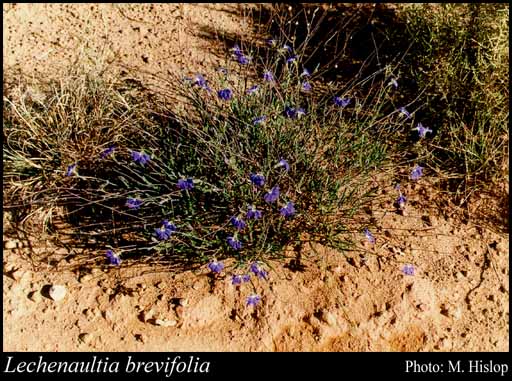- Reference
- Brunonia 9:18-20 (1987)
- Conservation Code
- Not threatened
- Naturalised Status
- Native to Western Australia
- Name Status
- Current
Tufted, ascending shrub, 0.15-0.5 m high. Fl. blue, Jul to Dec. Yellow or red sand. Undulating plains, sand dunes.







Scientific Description
Stems unribbed. Leaves flat, 2.5-4 mm long, 0.5-1 mm wide, Indumentum absent (leaves glabrous); margins entire. Bracteoles present, 3-3.5 mm long, glabrous. Pedicel pedicellate, Pedicel length the pedicels 9-17 mm long, glabrous. Calyx lobes present, Calyx length 3.7 mm long, glabrous. Corolla blue, 15-24 mm long, without auricles, not spurred, glabrous on the outside, hairy on the inside, with wings, 2.2-3.3 mm wide, wings present on both sides. Anthers free. Ovary inferior, not gibbose; style 9-12 mm long, glabrous; indusium single, hairy; ovules more than two. Flowers in July, August, September, October, November and December. Occurs in the Great Victoria Desert (GVD), Coolgardie (COO) and Mallee (MAL) IBRA Region(s), of the Eremaean (E) and South West (SW) Botanical Province.
Distribution
- IBRA Regions
- Avon Wheatbelt, Coolgardie, Great Victoria Desert, Mallee.
- IBRA Subregions
- Eastern Goldfield, Eastern Mallee, Katanning, Merredin, Shield, Southern Cross, Western Mallee.
- Local Government Areas (LGAs)
- Beverley, Coolgardie, Dundas, Esperance, Kalgoorlie-Boulder, Kent, Kondinin, Lake Grace, Menzies, Yilgarn.